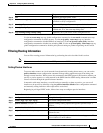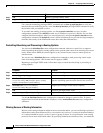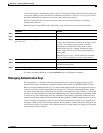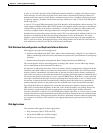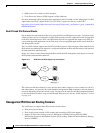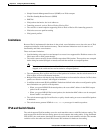
CHAPTER
39-1
Catalyst 3750-E and 3560-E Switch Software Configuration Guide
OL-9775-02
39
Configuring IPv6 Unicast Routing
Internet Protocol Version 6 (IPv6) is the network-layer Internet Protocol intended to replace Version 4
(IPv4) in the TCP/IP suite of protocols. This chapter describes how to configure IPv6 unicast routing on
the Catalyst 3750-E or 3560-E switch. For information about configuring IPv4 unicast routing, see
Chapter 38, “Configuring IP Unicast Routing.”For information about configuring IPv6 Multicast
Listener Discovery (MLD) snooping, see Chapter 25, “Configuring IPv6 MLD Snooping.” For
information on configuring IPv6 access control lists (ACLs) see Chapter 35, “Configuring IPv6 ACLs.”
To use this feature, the switch or stack master must be running the advanced IP services feature set. This
feature set includes all IP services features plus IPv6 host and unicast routing support. To enable IPv6
routing, you must also configure a switch database management (SDM) template to a dual IPv4 and IPv6
template. See the “SDM Templates” section on page 39-9.
Unless otherwise noted, the term switch refers to a Catalyst 3750-E or 3560-E standalone switch and to
a Catalyst 3750-E switch stack.
Note For complete syntax and usage information for the commands used in this chapter, see the Cisco IOS
documentation referenced in the procedures
This chapter consists of these sections:
• “Understanding IPv6” section on page 39-1
• “Configuring IPv6” section on page 39-10
• “Displaying IPv6” section on page 39-22
Understanding IPv6
The primary reason for using IPv6 is to increase Internet global address space to accommodate the
rapidly increasing number of users and applications that require unique global IP addresses. IPv4 uses
32-bit addresses to provide approximately 4 billion available addresses. Large blocks of these addresses
are allocated to government agencies and large organizations, and the number of available IP addresses
is rapidly decreasing. IPv6 incorporates 128-bit source and destination addresses and can provide
significantly more globally unique IP addresses than IPv4.





